In this post, you’ll learn what is a capacitor. Its definition, diagram, working, specifications, applications, capacitance color coding, and types of capacitors with pictures.
You can also download the PDF file of this article at the end.
What is a Capacitor?
Capacitors an electrical or electronic component that stores electric charges. A capacitor consists of 2 parallel plates made up of conducting materials, and a dielectric material (air, mica, paper, plastic, etc.) placed between them as shown in the figure.
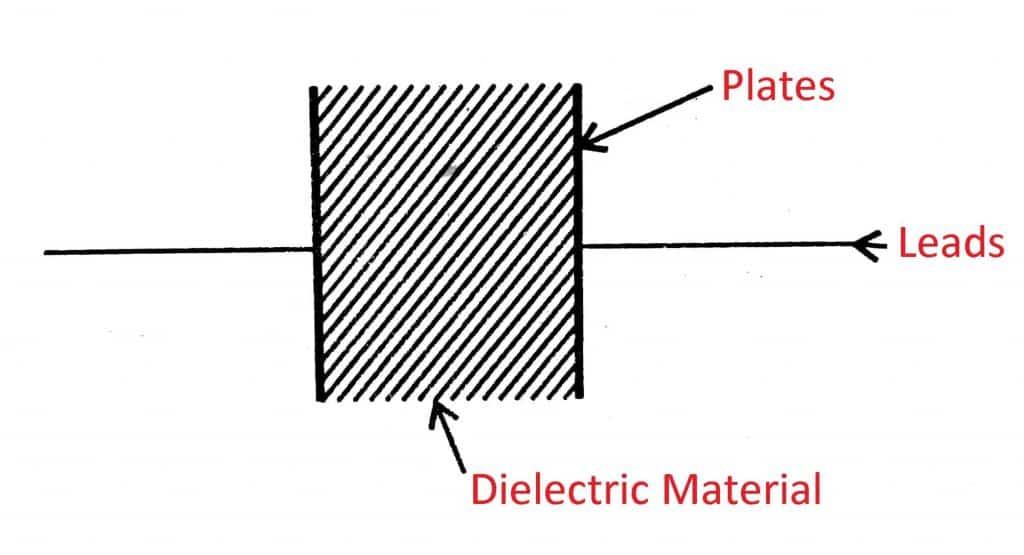
These dielectric materials are comprised of charge-collecting plates. There are two plates: one for positive charges and the other for negative charges.
Read Also: Different Types of Generators and Their Uses
What is Capacitance?
The effect of the capacitor is called capacitance. The definition of capacitance is the electric charge Q divided by the voltage V, and it is represented as
| C = Q/V |
- In coulombs, Q represents the electric charge.
- The capacitance in farads is denoted as C.
- V is the voltage, expressed in volts, across the plates.
Read Also: 25 Different Types of Electrician Tools and Their Uses
Specifications of Capacitors
The specifications of capacitors are:
1. Capacitance Value
The value of the capacitor is measured in terms of its capacitance value and is expressed in farads, microfarads, and nanofarads.
2. Voltage Rating
Voltage rating is the operating voltage of the capacitor and it is measured in volts.
3. Temperature Co-efficient
The temperature coefficient represents the stability in capacitance value with the temperature change. It is expressed in ppm/°c.
4. Frequency Range
The frequency range is the maximum frequency up to which the capacitor can work safely.
5. Dielectric Constant
The dielectric constant is the property of the dielectric that affects the capacitance value. It can be defined as the ratio of capacitance.
6. Dielectric Strength
Dielectric strength is the ability of the capacitor to withstand the voltage per unit thickness of the dielectric material without breakdown. It is measured in Kv/mm or Kv/cm. It depends on the thickness of the dielectric, temperature, and supply frequency.
7. Power Factor
The power factor indicates the minimum loss in the capacitor. It states the fraction of input power dissipated as heat loss in the capacitor. Lowering the power factor better will be the quality of the capacitor.
Read also: Types of Resistors and Their Symbols.
Classification of Capacitors
The types of capacitors that are available start with a small, delicate management capacitor that may be used with radio circuits or oscillators. In high-voltage power modification and smoothing circuits, metal-can-type capacitors are used to a great extent.
The types of capacitors are categorized as follows, based on their structures:
- Fixed Capacitors
- Variable Capacitors
- Trimmer Capacitor
The types of capacitors are categorized as follows based on polarization:
- Polarized
- Unpolarized
A polarized capacitor, also known as an electrolytic capacitor, is a crucial component in an electronic circuit. These capacitors are used to achieve high capacitive density.
Unpolarized capacitors are preferred over fully charged capacitors. Because it can be used in pure AC circuits and is not destroyed by inverted voltage. They also find usage in DC circuits, which do not have positive and negative closures. The unpolarized capacitor has a high repetition and a low spilling current.
Read Also: Types of Circuit Breakers: Working and Applications
Types of Capacitors
Following are the three different types of capacitors:
- Fixed Capacitors
- Mica Capacitors
- Ceramic Capacitors
- Paper Capacitors
- Plastic Capacitors
- Electrolytic Capacitors
- Film capacitor
- Adjustable Capacitors
- Variable Capacitors
Fixed Capacitors
The capacitors whose capacitance value is fixed are known as fixed capacitors.

Ex: Mica capacitor, paper capacitor, plastic capacitor, etc.
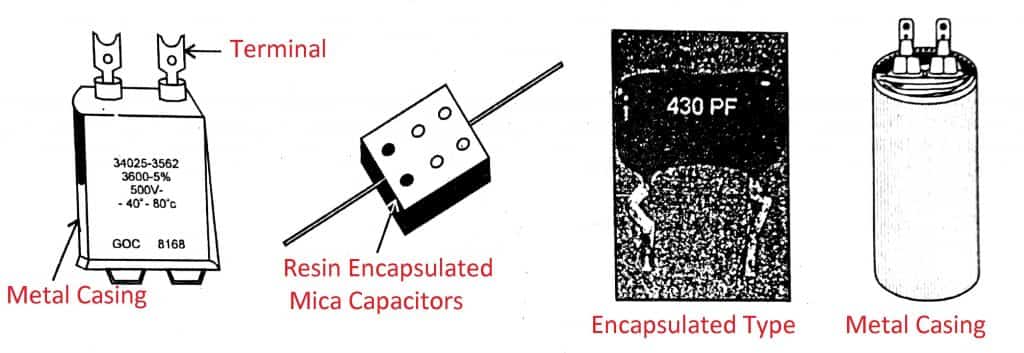

The different fixed capacitors are shown in the figure. Based on the dielectric material used fixed capacitors are further classified into:
- Mica Capacitors
- Ceramic Capacitors
- Paper Capacitors
- Plastic Capacitors
- Electrolytic Capacitors
- Film capacitor
Read Also: Basic Parts of Transformer & Its Functions [Names]
#1 Mica Capacitors
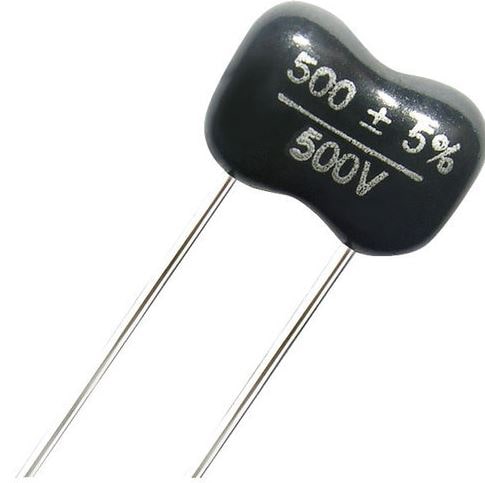
These types of capacitors are used as dielectric material. Mica sheets and metal foils are kept alternatively. The number of mica sheets and metal foils decides the capacitance value.
The constructional details are shown in the figure, from which it is clear that the alternate metal toils (1,3,5) and (2,4,6) are connected to form 2 separate sets, and a lead wire is connected to these two sets for External connection. The whole unit is placed in a metal casing or encapsulated with resin.
Applications of Mica Capacitors:
- In tuning and coupling circuits of radio and T.V. systems.
- In measuring instruments such as standard capacitors.
#2 Ceramic Capacitors
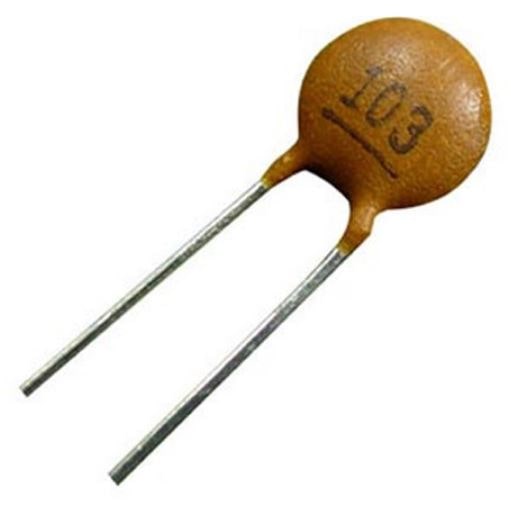
In these capacitors, ceramic is used as a dielectric material. Ceramic material is formed in the form thin disc or tube by mixing barium titanate, talc, and magnesium silicate at different ratios.
On the surface of the ceramic body metal film made of copper is coated and to this metal film lead wires are attached. The whole assembly is covered with plastic for external protection.
Applications of Ceramic Capacitors:
- In-tank circuits and matching circuits.
- As coupling and bypass components.
- The filter circuit with the resistor.
- In the transistor circuit.
- In T.V. transmitters and receivers.
#3 Paper Capacitors
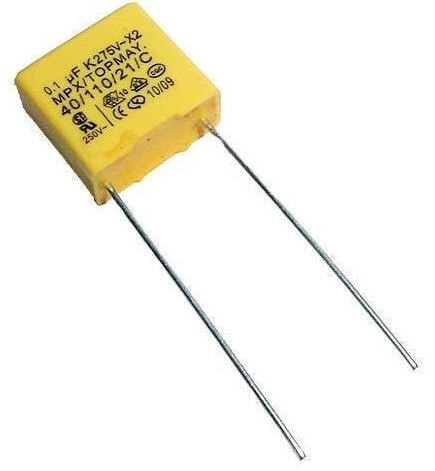
The figure represents the constructional details of the paper capacitor, in which paper acts as a dielectric material.
Here the paper is placed between two aluminum metal foils and is rolled into a cylindrical shape. Two lead wires are connected to metal foils for external connection. The whole unit is dipped in wax and placed in a metal casing.
Applications of Paper Capacitors:
- As stator in single-phase motors in table fans, grinders, water coolers, etc.
- In filter circuits and power supply systems.
#4 Plastic Capacitors
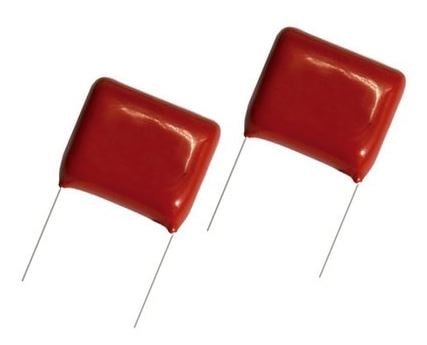
Constructional details of the plastic capacitor are shown in the figure, which consists of plastic as a dielectric material.
Two aluminum foils and plastic (polyester) film are kept alternately and rolled into a cylindrical shape. Copper leads are soldered on two metal foils and the whole unit is provided with resin molding.
Applications of Plastic Capacitors:
- For timing circuits
- tuning circuits, and
- In integrated circuits
#5 Electrolytic Capacitors
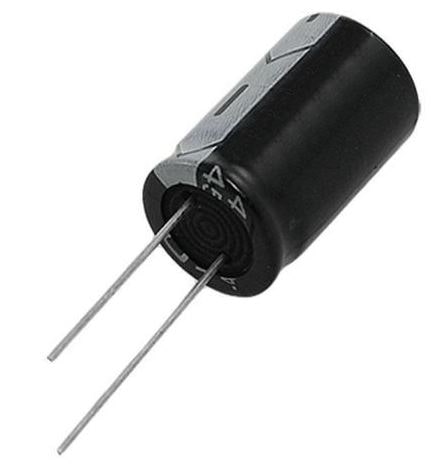
Electrolytic capacitors are polarized capacitors so these are used where energy with required polarity is necessary. Here oxide film obtained by a chemical reaction acts as a dielectric material.
Electrolytic capacitors are further classified into:
- Wet Type Electrolytic Capacitor
- Dry Type Electrolytic Capacitor
1. Wet Type Electrolytic Capacitor
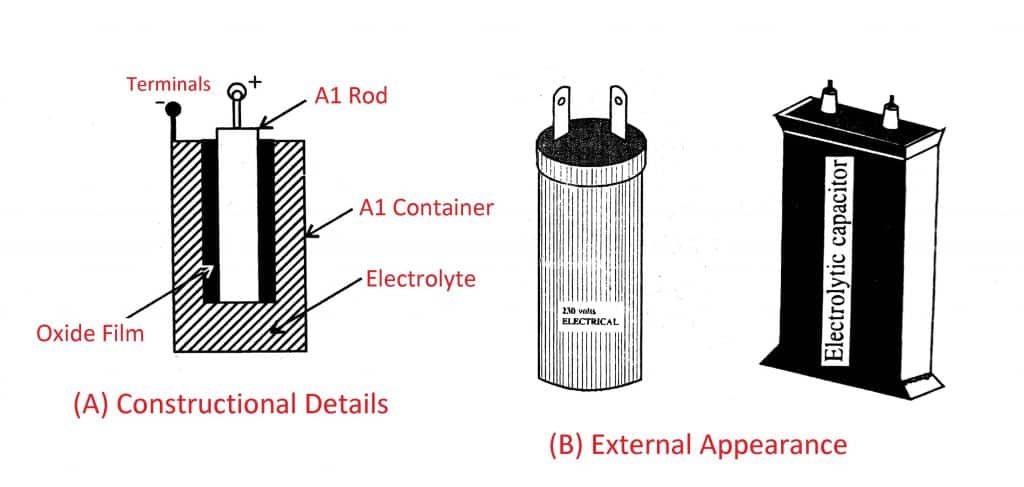
Construction details are shown in the figure, which consists of an aluminum rod placed in a base electrolyte placed in an aluminum container. Now D.C. current is passed through the c, with the help of the D.C. source connected between rod and container.
A thin film of oxide is deposited on the rod, which is connected to a positive terminal of the source. Thus rod acts as a positive terminal of the capacitor.
The source is switched off when the rod is covered by the oxide film completely. Thus rod acts as a (+)ve terminal, container as a (-)ve terminal with oxide film as a dielectric material.
2. Dry Type Electrolytic Capacitor

Constructional details of dry-type electrolytic capacitors are shown in the figure, which contains two aluminum sheets separated by a layer of gauze separator saturated with a liquid chemical of boric acid. Copper lead wires are soldered to the aluminum foils for external connection.
D.C. voltage is applied to the copper leads, which deposited aluminum oxide film on the foil that is connected to a positive terminal of the supply.
So that foil acts as (+)ve terminal and other foil acts as (-)ve terminal. Now the foils are rolled into a cylindrical shape and enclosed in an aluminum or plastic tube.
Applications of Electrolytic Capacitors:
- As filters in rectifier circuits.
- In T.V. and radio receivers for tuning purposes.
- As a bypass capacitor in amplifier circuits.
Sometimes tantalum (Ta) foils with Tantalum Pentoxide as dielectric are used instead of aluminum foils and the name of the capacitor becomes tantalum electrolytic capacitor. The constructional details of the tantalum capacitor are the same as the aluminum electrolytic capacitor.
#6 Film Capacitor
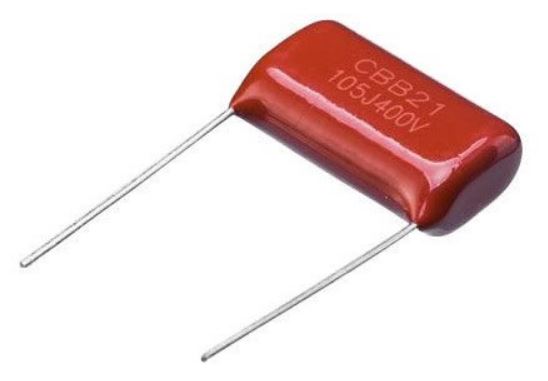
This type of capacitor has an insulating plastic film as the dielectric, which is combined with paper as a carrier for the electrodes. The electrodes of film capacitors are metalized by aluminum or zinc applied directly to the surface of the plastic film.
These two conductive layers are twisted into a cylinder-shaped winding which is usually flattened in shape. The reason they are manufactured in a flat shape is to reduce mounting space requirements on the printed circuit board. These are used in electronic devices, AC and DC microelectronics, and electronic circuits.
Read Also: Different Types of Electric Motors: Their Working & Uses
#2 Adjustable Capacitors
The capacitors whose value can be adjusted are known as adjustable capacitors. These are always connected either in series or in parallel with fixed capacitors. These types of capacitors are used where a small change in capacitance is required.

Ex: Trimmer & Padders.
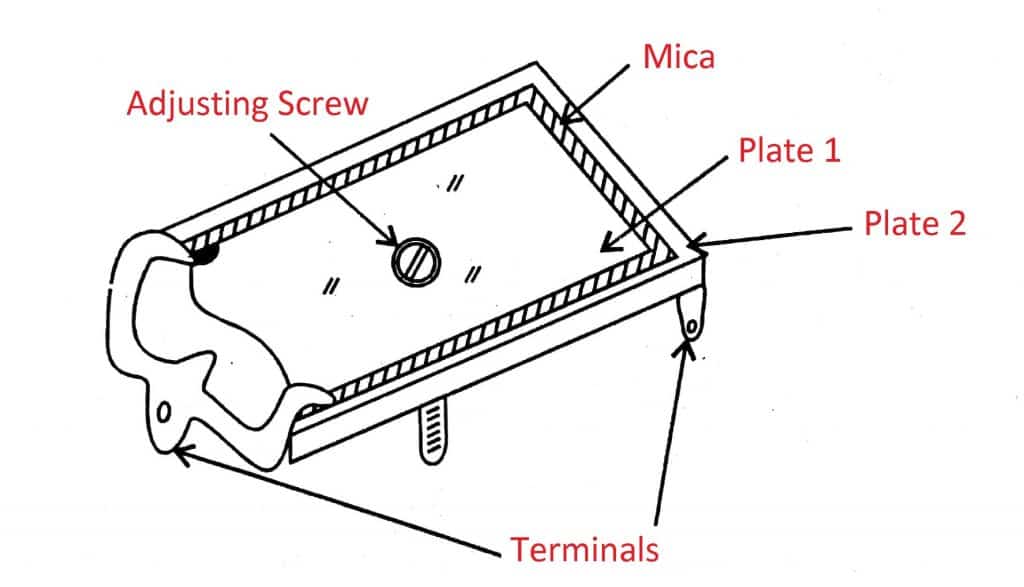
The trimmers are shown in the figure.
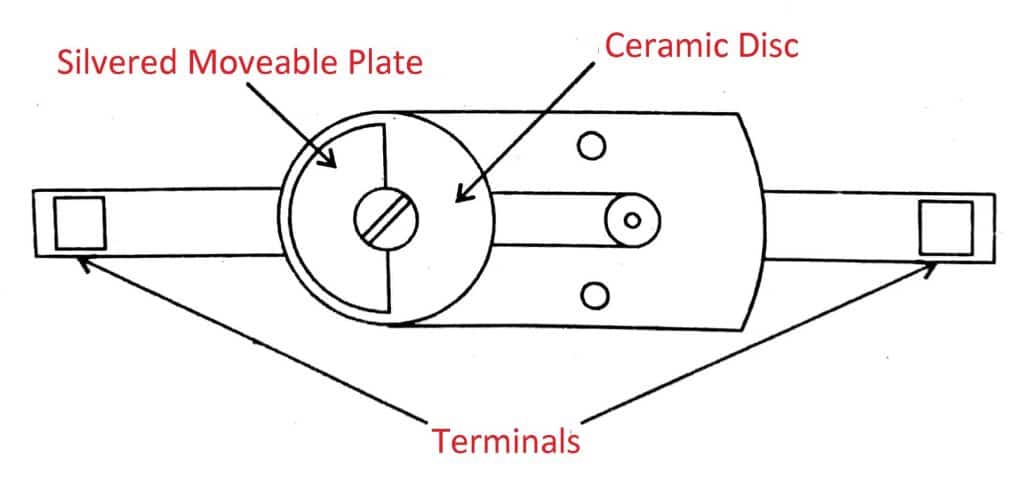
Adjustable capacitors are very small capacitors, that are used as secondary capacitors. These are connected in series or parallel with fixed capacitors. If the adjustable capacitor is connected in series with a fixed capacitor then it is called a trimmer. If it is connected in parallel with a fixed capacitor then, it is called a padder.
Cup Type Adjustable Capacitor:
The figure represents the cup-type trimmer/padder, in which the value of capacitance can be varied by varying the distance between the cups. It contains a fixed bottom cup above which the upper cup is placed with a screw, that can be either clockwise or in anticlockwise directions.
By rotating the screw to which the upper cup is connected, the distance between the upper cup and the bottom cup can be adjusted to get the required capacitance value. These cups are made up of aluminum and air acts as a dielectric material.
Applications of Adjustable Capacitors:
- In coupling circuit in radio receivers.
- In tuning circuits for fine-tuning.
Read Also: Types of Insulators Used In Power Transmission Lines
#3 Variable Capacitors
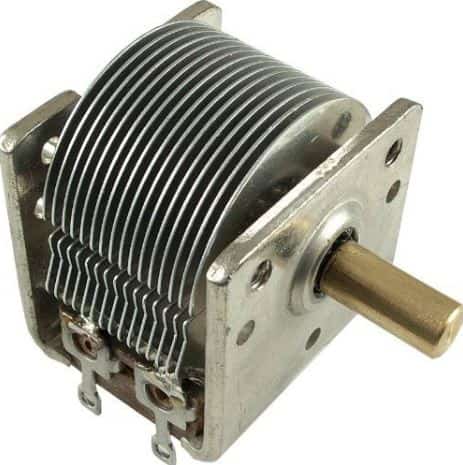
The capacitors whose capacitance value can be varied continuously are called variable capacitors. The figure represents the constructional details of variable capacitors, which consist of 2 sets of semi-circle plates out of which one set is fixed called a stator, and another set is movably called a rotor.
In these types of capacitors, the rotor is fixed to the shaft which rotates the rotor plates in or out of the fixed plates. This rotation of the rotor increases or decreases the area of contact between the rotor and stator, which varies the capacitance value. When 2 or 3 sets are placed on the same shaft they are called gang condensers or gang capacitors figure (B).
Applications of Variable Capacitors:
- In radio turning circuits for selection of radio stations.
- In the oscillator adjust the resonant frequency.
Read Also: What is D.C. Generator and Their Working?
Difference Between Trimmers & Padders

Applications of Capacitors
- Capacitors are used to store electrical energy.
- To resist the change in the applied voltage.
- To block d.c. and allow a.c; through it.
- It improves the p.ſ. of a circuit.
- To start single-phase a.c. motor.
- To carry high-frequency signals and block low-frequency signals.
That’s it, thanks for reading. If you like this article share it with your friends. Let us know in the comments if you have any questions about “types of capacitors“.
Want free PDFs sitting at home? Then subscribe to our newsletter.
Download PDF of this article:
Read more about machines in the blog:
- Types of Transformers and Their Working
- Logic Gates with Truth Table [AND, OR, NAND, NOR]
- Fundamental Parts of DC Generators & Their Functions
FAQs
A tiny rechargeable battery that holds energy in the form of an electrical charge is called a capacitor. There are three sorts of capacitors based on their structure: trimmer capacitors, variable capacitors, and fixed capacitors.
A capacitor is a device that stores charges inside an electrical circuit. A capacitor operates on the principle that bringing an earthed conductor close to a conductor causes its capacitance to grow significantly. As a result, a capacitor consists of two equal and oppositely charged plates that are spaced apart.
One of the capacitors that is used the most frequently is the ceramic capacitor. Because ceramic capacitors are non-polar components, they can be included in circuits in any direction.
Electrical capacitance is measured in Farads, the SI unit of measurement denoted by the letter F. Michael Faraday, an English physicist, was mainly responsible for naming this unit.
Please can you send me the PDF.
regards
Andrew
The PDF file has been sent to your inbox.
Very well!
Can you please send me the Pdf-Document?
Thank you.
You’re welcome. The PDF file has been sent to your inbox.
can you please send me the pdf thanks.
The PDF file has been sent to your inbox.
send pdf file, good information
The PDF file has been sent to your inbox.
Woow thank u so much you really helped me a lot💗💗
You’re welcome. Keep visiting 😉
THIS IS AMAZING.. ITS A BIG HELP FOR MY SELF STUDY AND FOR MY COMING TRAINING.. THANK YOU SO MUCH.. THANKS THE AUTHOR.. GOD BLESS YOU..
You’re most welcome. Keep visiting 😉
Oh wow, I got through several websites like electrical4u. but never had a chance to get this type of explanation to the knowledge great work.
Thanks for your valuable feedback. I appreciate it. Keep visiting 😉
This article was really helpful kindly email me this pdf
Thanks for your feedback. The PDF file has been sent to your inbox.
I need the pdf for the capacitor
The PDF file has been sent to your inbox.
It is really very helpful. Keep it up. If possible, could u please mail me this PDF?
Thanks for your feedback. The PDF file has been sent to your inbox.
Understood all the information
I’m glad it was helpful for you.
This is just nice i would like to have it in pdf
The PDf file has been sent to your inbox.
Me interesa descargarlo, muchas gracias
You’re welcome.
Please send me the PDF . Thanks
The PDF file has been sent to your inbox.
Please send me the PDF . Thanks!
The PDF file has been sent to your inbox.
i need the pdf file thanks
The PDF file has been sent to your inbox.
Great
Thanks.
I appreciate your assistance in sending in the pdf version..
Thank you
You’re welcome.
Hi Saif, nice work but how can we download this article?
Hi there, I just sent you the PDF file to your inbox.
Kindly send a PDF document
The PDF file has been sent to your inbox.
no download option for pdf on capacitors plz make it possible for download
Hi there, I just updated the article with a PDF file. Now you can download it.
Send pdf
The PDF file has been sent to your inbox.